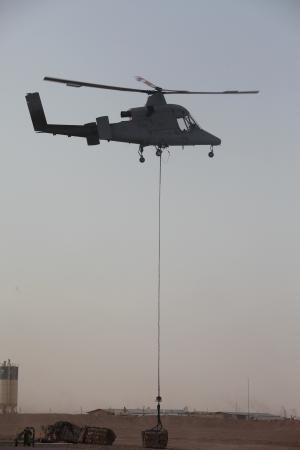Kaman K1200 Preprogrammed To Fly Resupply Missions
The Marine Corps has recently used the unmanned aerial vehicle as a cargo transportation platform in Helmand Province. The UAV is able to bring supplies, equipment and gear to preprogrammed coordinates placed in a computer system. A new step forward was taken when landing support specialists with Combat Logistics Battalion 5, 1st Marine Logistics Group (Forward) conducted the first series of hot hook-ups with the UAV at Camp Dwyer Afghanistan, May 23-25.

Hot hook-ups are when LS specialists attach cargo to a hovering air platform. The Kaman K1200 unmanned aerial vehicle is controlled by an aerial vehicle operator for takeoff and landing but is preprogrammed to fly independently and hover once it has reached its destination. Because of the long sling attached to the UAV, the aircraft is able to hover high above the ground when picking up or delivering loads. This capability makes it available at any location without requiring a specific landing zone. With no pilot on board, the drone is a safer method of transportation in a combat zone; plus it can go back and forth for multiple loads.
Landing support Marines conduct helicopter support team missions on an almost daily basis with CH-53E Sea Stallions and MV-22 Ospreys, but their new encounter with the remote-controlled UAV has brought about additional benefits. “The computer can take better accountability of wind speed and mitigate the hook swing,” said Lance Cpl. Vihn Vu, landing support specialist, CLB-5, 1st MLG (Fwd). “The sling on the UAV is a lot longer, so the helicopter is higher up in the air causing less down draft. And the rotors are made out of wood, which takes away the factor of static electricity.”
Vu also said the Marines under the aircraft are able to communicate with the person controlling the aircraft via radio, so they can tell the operator which direction to adjust for a smoother hook-up. “All of these factors contribute to the HST being much safer,” said Vu. “The computer eliminates the factor of human error.”
Until recently, the UAV was only used to deliver loads to Forward Operating Bases Geronimo and Payne. Both FOBs have an aerial vehicle operator on site that take over control of the UAV once it is within view. “All the units in the area of operations are getting the word that we have this new platform,” said Staff Sgt. Terry Palmer, landing support chief, CLB-5, 1st MLG (Fwd). “The goal is to be able to deliver to any area that sends a request. The external lift capability of transporting cargo is vital, and with [improvised explosive devices] being a huge threat to convoys, the UAV [avoids] the common threats of the battle field."
After receiving training, the CLB-5 landing support Marines spent hours practicing the hook-ups as well as sending some loads out to FOBs. Although only a small group received the new UAV HST training, they represent the first working with platform that promises to become a vital asset to the Marine Corps.
“Landing support is a fairly small community so when we go back to [Camp Pendleton, CA], or wherever we came from, we can share the knowledge we learned,” said Palmer. “Even though other Marines haven’t done it yet, they will have a good understanding of how it works.”
 ANN's Daily Aero-Linx (05.06.25)
ANN's Daily Aero-Linx (05.06.25) ANN's Daily Aero-Term (05.06.25): Ultrahigh Frequency (UHF)
ANN's Daily Aero-Term (05.06.25): Ultrahigh Frequency (UHF) ANN FAQ: Q&A 101
ANN FAQ: Q&A 101 Classic Aero-TV: Virtual Reality Painting--PPG Leverages Technology for Training
Classic Aero-TV: Virtual Reality Painting--PPG Leverages Technology for Training Airborne 05.02.25: Joby Crewed Milestone, Diamond Club, Canadian Pilot Insurance
Airborne 05.02.25: Joby Crewed Milestone, Diamond Club, Canadian Pilot Insurance



